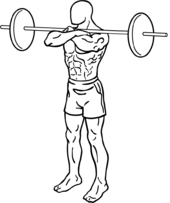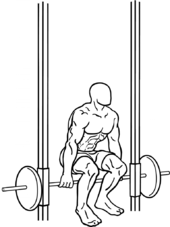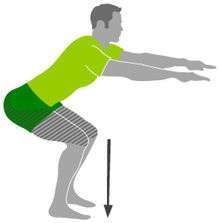Squat (exercise)

In strength training and fitness, the squat is a compound, full body exercise that trains primarily the muscles of the thighs, hips and buttocks, quadriceps femoris muscle (vastus lateralis, vastus medialis, vastus intermedius and rectus femoris), hamstrings, as well as strengthening the bones, ligaments and insertion of the tendons throughout the lower body. Squats are considered a vital exercise for increasing the strength and size of the legs and buttocks, as well as developing core strength. Isometrically, the lower back, the upper back, the abdominals, the trunk muscles, the costal muscles, and the shoulders and arms are all essential to the exercise and thus are trained when squatting with the proper form.[1]
The squat is one of the three lifts in the strength sport of powerlifting, together with deadlifts and bench press. It is also considered a staple in many popular recreational exercise programs such as Stronglifts 5x5, Starting Strength, AlphaDestiny's Novice Program, and Ice Cream Fitness 5x5.
Muscles engaged
- Primary muscles
Gluteus maximus (glutes), quadriceps (quads)[2]
- Secondary muscles (synergists/stabilizers)
- Erector spinae, transverse abdominus, gluteus medius/minimus (abductors), adductors, soleus, gastrocnemius, hamstrings[2]
Form
The movement begins from a standing position. Weights are often used, either in the hand or as a bar braced across the trapezius muscle or rear deltoid muscle in the upper back.[3] The movement is initiated by moving the hips back and bending the knees and hips to lower the torso and accompanying weight, then returning to the upright position.
Squats can be performed to varying depths. The competition standard is for the crease of the hip (top surface of the leg at the hip joint) to fall below the top of the knee;[4] this is colloquially known as "parallel" depth.[5] Confusingly, many other definitions for "parallel" depth abound, none of which represents the standard in organized powerlifting. From shallowest to deepest, these other standards are: bottom of hamstring parallel to the ground;[6] the hip joint itself below the top of the knee, or femur parallel to the floor;[7] and the top of the upper thigh (i.e., top of the quadriceps) below the top of the knee.[8]
Squatting below parallel qualifies a squat as deep while squatting above it qualifies as shallow.[3] Some authorities caution against deep squats;[9] though the forces on the ACL and PCL decrease at high flexion, compressive forces on the menisci and articular cartilages in the knee peak at these same high angles.[10] This makes the relative safety of deep versus shallow squats difficult to determine.
As the body gradually descends, the hips and knees undergo flexion, the ankle extends ("dorsiflexes") and muscles around the joint contract eccentrically, reaching maximal contraction at the bottom of the movement while slowing and reversing descent. The muscles around the hips provide the power out of the bottom. If the knees slide forward or cave in then tension is taken from the hamstrings, hindering power on the ascent. Returning to vertical contracts the muscles concentrically, and the hips and knees undergo extension while the ankle plantarflexes.[3] In a weight bearing squat, the heels should always maintain contact with the floor throughout the movement. Weight shifting forward on to the toes, and off the heels creates unnecessary stress on the knee joint. This added stress may lead to inflammation or other overuse injuries.[11]
Two common errors include descending too rapidly and flexing the torso too far forward. Rapid descent risks being unable to complete the lift or causing injury. This occurs when the descent causes the squatting muscles to relax and tightness at the bottom is lost as a result. Over-flexing the torso greatly increases the forces exerted on the lower back, risking a spinal disc herniation.[3]
Another error where health of the knee joint is concerned is when the knee is not aligned with the direction of the toes. If the knee is not tracking over the toes during the movement this results in twisting/shearing of the joint and unwanted torque affecting the ligaments which can soon result in injury. The knee should always follow the toe. Have your toes slightly pointed out in order to track the knee properly.
Equipment
Various types of equipment can be used to perform squats. A power cage can be used to reduce risk of injury and eliminate the need for a spotting partner. By putting the bar on a track, the Smith machine reduces the role of hip movement in the squat and in this sense resembles a leg press.[12] Other equipment used can include a weight lifting belt to support the torso and boards to wedge beneath the ankles to improve stability and allow a deeper squat (weightlifting shoes also have wooden wedges built into the sole to achieve the same effect). Heel wedges and related equipment are discouraged by some as they are thought to worsen form over the long term.[13] The barbell can also be cushioned with a special padded sleeve.
World records
On October 8, 2011, Jonas Rantanen of Finland performed a squat with a weight of 575 kg (1268 lb) at the Bullfarm Powerlifting Championships in Helsinki, beating the previous record by Donnie Thompson (USA) of 573 kg (1265 lb).[14]
The single-ply squat record is held by Dustin Slepicka (USA) at 500 kg (1102 lb).[15]
The raw world record with knee wraps is 485 kg done by Andrey Malanichev at ProRaw Big Dogs in Melbourne, Australia.[16]
The raw world record without knee wraps belongs to Ray Williams who lifted 1005 lb (456 kg) on October 16, 2016, at USAPL Raw Nationals in Atlanta, Georgia .[17]
The women world record belongs to Olga Gemaletdinova who lifted 310.0 kg on May 5, 2011.[18]
The most squats with 130 kg in two minutes was Netherlands woman Maria Strik. She squat-lifted a weight of 130 kg, 29 times within two minutes.[19]
Variants
The squat has a number of variants, some of which can be combined:
Barbell



- Back squat – the bar is held on the back of the body at the base of the neck or lower across the upper back. In powerlifting the barbell is often held in a lower position in order to create a lever advantage, while in weightlifting it is often held in a higher position which produces a posture closer to that of the clean and jerk. These variations are called low bar and high bar, respectively.
- Box squat – at the bottom of the motion the squatter will sit down on a bench or other type of support then rise again. The box squat is commonly utilized by power lifters to train the squat. Pausing on the box creates additional stimulus in the hips and glutes. Some people believe this form of isometric training allows for greater gains in the squat compared to a traditional Olympic style squat, while others contend that the increased spinal loading creates more opportunity for injury.
- Sumo squat- The barbell is rested on the shoulders in the usual squat position. The legs should be slightly wider than shoulder width apart and the feet should be pointed outwards. when squatting, you should feel a stretch on the adductor longues and adductor magnus muscles which are found on the inner thigh.
- Front squat – the weight (usually a barbell) is held in front of the body across the clavicles and deltoids in either a clean grip, as is used in weightlifting, or with the arms crossed and hands placed on top of the barbell.
- Hack squat – the barbell is held in the hands just behind the legs; this exercise was first known as Hacke (heel) in Germany.[20] According to European strength sports expert and Germanist Emmanuel Legeard this name was derived from the original form of the exercise where the heels were joined. The hack squat was thus a squat performed the way Prussian soldiers used to click their heels ("Hacken zusammen").[21] The hack squat was popularized in the English-speaking countries by early 1900s wrestler George Hackenschmidt. It is also called a "rear deadlift".
- Overhead squat – the barbell is held overhead in a wide-arm snatch grip; however, it is also possible to use a closer grip if balance allows.
- Zercher squat – the barbell is held in the crooks of the arms, on the inside of the elbow. One method of performing this is to deadlift the barbell, hold it against the thighs, squat into the lower portion of the squat, and then hold the bar on the thighs as you position the crook of your arm under the bar and then stand up. This sequence is reversed once the desired number of repetitions has been performed. Named after Ed Zercher, a 1930s strongman.
Lunge
- Split squat – an assisted one-legged squat where the non-lifting leg is rested on the ground a few 'steps' behind the lifter, as if it were a static lunge.
- Bulgarian squat – performed much like a split squat, but the foot of the non-lifting leg is rested on a knee-high platform behind the lifter.
Other

- Belt squat – is an exercise performed the same as other squat variations except the weight is attached to a hip belt i.e. a dip belt
- Goblet squat – a squat performed while holding a kettlebell next to one's chest and abdomen with both hands.
- Sissy squat – a squat with several sorts (dumbbell, weight plate, Smith machine, barbell, bodyweight). In the most common variant, a dumbbell is held behind the legs while the heels are lifted off the ground and the torso remains flat while the lifter leans backwards; sometimes done with a plate held on the chest and one arm holding onto a chair or beam for support. Unlike most other squat variations, Vince Gironda promoted sissy squat as a rectus femoris isolation exercise.
- Smith squat – a squat using a Smith machine. Hack squats can be done easily this way, as in the picture.
- Trap bar squat – a trap bar is held with hands at the sides.
Bodyweight

- Bodyweight squat – done with no weight or barbell, often at higher repetitions than other variants.
- Overhead squat – a non-weight bearing variation of the squat exercise, with the hands facing each other overhead, biceps aligned with the ears, and feet hip-width apart. This exercise is a predictor of total-body flexibility, mobility, and possible lower body dysfunction.
- Face the wall squat – performed with or without weights. It is primarily to strengthen the vertebrae tissues. In the Chinese variant (面壁蹲墙) weights are not used. Toes, knees and nose line up almost touching the wall. Advanced forms include shoeless, wrists crossed behind the back, and fists in front of forehead, all performed with toes and knees closed and touching the wall.
- Hindu squat – done without weight where the heels are raised and body weight is placed on the toes; the knees track far past the toes.
- Jump squat – a plyometrics exercise where the squatter engages in a rapid eccentric contraction and jumps forcefully off the floor at the top of the range of motion.
- Pistol – a bodyweight single leg squat done to full depth, while the other leg is extended off the floor. Sometimes dumbbells, kettlebells or medicine balls are added for resistance.
- Shrimp squat - also called the flamingo squat, a version of the pistols squat where instead of extending the non-working leg out in front, it is bent and placed behind the working leg while squatting, perhaps held behind in a hand.[22]

Injury considerations
Although the squat has long been a basic element of weight training, it has in recent years been the subject of considerable controversy. Some trainers allege that squats are associated with injuries to the lumbar spine and knees.[23] Others, however, continue to advocate the squat as one of the best exercises for building muscle and strength. Some coaches maintain that incomplete squats (those terminating above parallel) are both less effective and more likely to cause injury[1] than a full squat (terminating with hips at or below knee level). A 2013 review concluded that deep squats performed with proper technique do not lead to increased rates of degenerative knee injuries and are an effective exercise. The same review also concluded that shallower squats may lead to degeneration in the lumbar spine and knees in the long-term.[24]
See also
References
- 1 2 Rippetoe, Mark (2007). Starting Strength: Basic Barbell Training, p.8. The Aasgaard Company. p. 320. ISBN 0-9768054-2-1.
- 1 2 "Bodyweight Squat". acefitness.org. American Council on Exercise. Retrieved 27 March 2011.
- 1 2 3 4 Brown, SP (2000). Introduction to exercise science. Lippincott Wims & Wilkins. pp. 280–1. ISBN 0-683-30280-9.
- ↑ Technical Rules Book 2013. International Powerlifting Federation. powerlifting-ipf.com
- ↑ Hanna, Wade (March 2002) Squat depth clarified. USA Powerlifting Online Newsletter. Usapowerlifting.com. Retrieved on 2013-08-05.
- ↑ Hi- and Low-bar Squatting. Home.comcast.net. Retrieved on 2013-08-05.
- ↑ 6 Things I Really Dislike. T Nation. Retrieved on 2013-08-05.
- ↑ A Closer Look at the Parallel Squat. Bigger Faster Stronger, March/April 2008, pp. 36–38.
- ↑ Kellis, E, Arambatsi, F, Papadopoulos, C. (2005). "Effects of load and ground reaction forces and lower limb kinematics during concentric squats". Journal of sports sciences. 23 (10): 1045–55. doi:10.1080/02640410400022094. PMID 16194981.
- ↑ Clarkson, HM, and Gilewich, GB (1999) Musculoskeletal Assessment: Joint Range Of Motion And Manual Muscle Strength. Baltimore, MD: Williams and Wilkins, p. 374, ISBN 0683303848.
- ↑ "Squat". lift.net.
- ↑ Cornacchia, pp. 121, 125.
- ↑ McRobert, S (1999). The Insider's Tell-All Handbook on Weight-Lifting Technique. CS Publishing. ISBN 9963-616-03-8.
- ↑ Jonas Rantanen Breaks World Record Squat. SeriousPowerLifting. Retrieved 2013-03-15.
- ↑ "Powerlifting watch".
- ↑ "Andrey Malanichev squats 485 kg RAW 2016".
- ↑ Raw Squat World Record PowerliftingWatch
- ↑
- ↑ Glenday, Craig (2013). 2013 Guinness World Records Limited. p. 104. ISBN 978-1-908843-15-9.
- ↑ George Hackenschmidt, The Way To Live in Health and Physical Fitness, York, 1908, p.70
- ↑ Emmanuel, Legeard (2008). Les Fondamentaux. Paris. p. 142.
- ↑ Periodic Table of Bodyweight Exercises with Clickable Videos. Strength.stack52.com. Retrieved on 2015-04-24.
- ↑ Cornacchia, p. 120.
- ↑ Hartmann H, Wirth K, Klusemann M (2013). "Analysis of the load on the knee joint and vertebral column with changes in squatting depth and weight load". Sports Med. 43 (10): 993–1008. doi:10.1007/s40279-013-0073-6. PMID 23821469.
Bibliography
- Cornacchia, Lorenzo; Bompa, Tudor O.; Di Pasquale, Mauro G.; Mauro Di Pasquale (2003). Serious strength training. Champaign, IL: Human Kinetics. ISBN 0-7360-4266-0.
